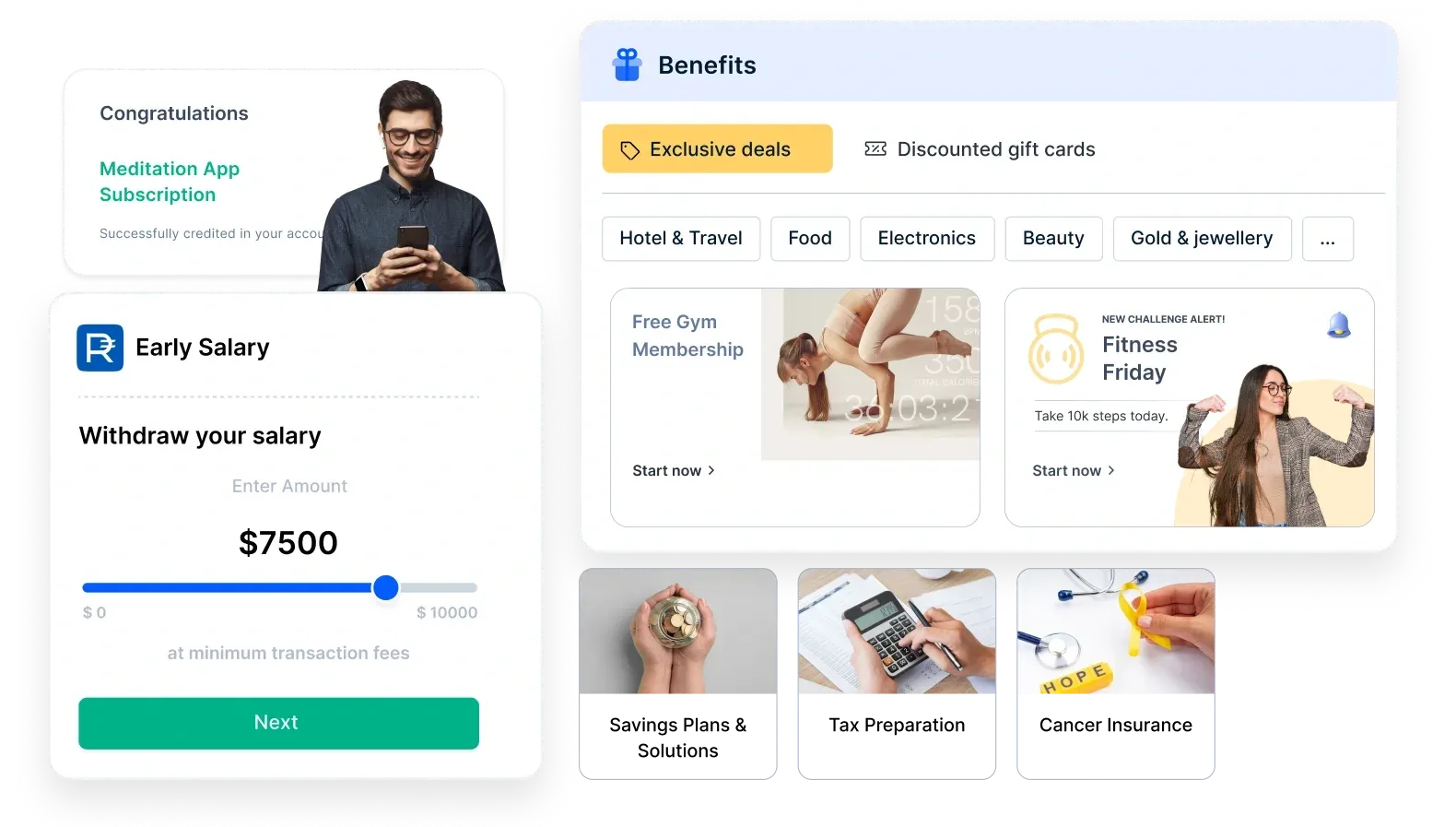On this page
Flexible work arrangements went from optional to an expected norm for specific job profiles. The benefits of flexible work arrangements for employees and employers alike are countless.
And, if flexible work options were on the rise before, the 2020 pandemic gave them the much-needed push. Nowadays, offering a flexible work environment is crucial if you want to avoid recruitment issues.
Of course, there are many job profiles where flexible work schedules wouldn't work. For example, call center agents that have to be online during core hours to reach their customers. Or construction workers who cannot work location-independent since they have to be on-site.
But, for jobs that can be done over a laptop, offering flexible work hours or office space can be a compelling incentive to skyrocket employee engagement.
What are flexible work arrangements?
Flexible work arrangements are agreements between employers and employees, allowing the employees a certain degree of scheduling freedom. They can either schedule their hours or choose their work location instead of the typical office space.
Flexible schedules can be anything that’s different from the typical 9-to-5, five days a week job. This flexibility can be tied to the schedule, hours, or location of work. In short, flexible schedules allow employees to choose when, where, and how they will do their job.
This type of flexibility in the workspace became necessary during the Covid-19 outbreak. From that point forward, it continued growing exponentially. And, most importantly, we have all the right tools and technology that allows it.
"Our best estimate is that 25-30% of the workforce will be working from home multiple days a week by the end of 2021", says Kate Lister, president of Global Workplace Analytics, in their Work-At-Home After Covid-19 forecast.
Why should companies adopt flexible work arrangements: 12 Key benefits
Offering flexible work schedules brings tons of benefits not just to employees but to companies and employers alike. Here's what to expect once you start showing your staff more flexibility:
1. More successful recruitment
Embracing flexible work schedules isn’t just about convenience—it’s a strategic move that brings measurable results. Profiles like designers, developers, marketers, translators, and recruiters expect a flexible work environment. By refusing to offer flexibility in your job posting, you will repel a large portion of the talent pool and decrease your recruiting success.
2. Increased employee retention rates
Research suggests you can increase job satisfaction by allowing your employees to work from home or with a flexible schedule. And we all know that happy employees are far more likely to keep their jobs long-term. Give your staff some freedom, and you'll be surprised by the outcome.
3. Reduced office space and commute costs
For a startup or a small business without enough capital for office space, remote working can save tons of costs. Plus, saving on electricity and reducing your commuting will make your company greener and eco-friendly.
4. Access to global top-talent pools
Perhaps the most crucial pro of having a location-independent remote team is the access to worldwide talents. Don't restrict your recruitment opportunities by searching for local specialists.
Instead, tap into the global pool of talents and hire someone capable, even if they live halfway across the world. We have the technology to structure an entirely digital workforce.
5. A better work-life balance
The work-life balance is perhaps one of the most important aspects of a job nowadays. In many cases, employees find it even more vital than the actual pay wage. A healthy work-life balance gives employees time for their personal lives, to spend time with family or do other activities they enjoy.
6. Improved health and wellbeing
Employees with flexible jobs suffer less stress and are much more relaxed than those with strict work schedules. Regardless of whether they're stressed about work or personal issues, some flexibility in their schedule can change that.
7. Increased productivity and job satisfaction
It's not like remote workers do nothing but sit around in their pajamas all day long. Contrary to popular belief, remote employees can work longer hours, often unable to unplug and detach. It's a paradox - as soon as you have freedom, you start loving your job and start working even more.
8. Better employee engagement
Employees who can have flexibility in their schedules work hours show higher employee engagement. That's a result of the appreciation they feel for the creative freedom to work at their own pace. Typically, employees who are trusted to work flexible hours repay this "favor" with more engagement and productivity.
9. Reduced stress and burnout rates
Flexible schedules can prevent burnout caused by overworking. Flexibility is vital for all employees, but even more so for profiles like students or young parents. For these categories, flexible working hours or the possibility to work from home can be priceless.
10. Decreased commute costs
Employees that work from home or are location-independent save much money on transport from and to work. And, it's not just money they're saving, but also time. Those two hours you spend traveling back and forth are better spent with your family or loved ones. As a bonus, by not traveling as often, you'll reduce your carbon footprint.
11. More choices in real estate
Surprisingly, work flexibility comes with an increased choice of real estate options. Employees can buy or rent more affordable homes without worrying if they're close to the office space. Alternatively, they could even relocate to a suburban area without worrying about the distance to work.
12. A better living standard
The global market goes both ways - employers can access worldwide talents, and employees can get international jobs.

Types of flexible work arrangements
There can be different types of flexible work arrangements based on where the flexibility aspect is placed. For instance, flexibility can be allowed around the working hours or the location and place of work. Let’s explore the key models below:
1. Flextime
With the flextime model, employees can choose their working hours and create their schedules. As long as they fill their hourly quota for the week (typically 40 hours a week for full-time jobs), they can decide the hours.
The flextime model is typical for jobs where time zones don't matter (jobs with no customer contact like designers, content writers, etc.). So, in this case, the employee will clock in 40 hours a week but in a schedule that fits them. Instead of 9 to 5, they might decide to work some hours at noon and the rest after midnight. It doesn't matter as long as the job is done.
2. Remote work
If we weren't aware of the benefits of remote work before, the 2020 pandemic opened our eyes. With employers having no choice but to let their employees work from home, we began realizing that we aren't paying for seat warmers but a job well done.
Are you still not convinced that your remote employees will be productive? Just think of companies like Twitter allowing their employees to work from home forever (if they wanted to). And remote work doesn't necessarily equal work from home - employees can choose to work from anywhere they want.
3. Compressed workweek
A compressed work schedule is another type of work arrangement that could be suitable for specific job profiles. Simply put, a compressed workweek entails working long hours on some days but taking more days off in return.
For instance, instead of working 5 days a week, 8 hours a day, you can work 10 hours, 4 days a week. Then, you can take +1 day off (together with the weekend, you'll now have 3 free days in a row).
4. Job sharing
As a concept, job sharing is beneficial to both employees and employers. Employees that cannot work 40 hours a week can practically "share their employment" with another part-time worker. So, instead of one person working full-time, there will be two employees working part-time.
Job sharing is a practice that companies that deal with remote freelance teams use regularly. By its nature, it's very similar to having part-time jobs instead of committing full time to one company.
5. Split shifts
For instance, instead of working a complete 8-hour shift, you can split your shift into two, 4-hour intervals. With this, you free up some time in between to take care of private tasks.

You can modify all these types of flexible schedules based on the business nature. And, although those five are the most commonly used types of flexible scheduling, the list goes on.
Some employers give vacation days flexibility or decide to work with freelancers (project-based). Others implement a hybrid model (work from home on some days and the office space on others).
All these models can be adapted based on the business nature. And, although those five are the most commonly used types of flexible scheduling, the list goes on.
Some employers give vacation days flexibility or decide to work with freelancers (project-based). Others implement a hybrid model (work from home on some days and the office space on others).
How to design a flexible work schedule?
For employers, declaring that they’re going to move to a flexible work schedule design so that employees can better balance work and life is an easy move - it can seem like a quick win when tough.
But actually, implementing and managing that flexible schedule is a little bit more tricky. First, you need to consider both the needs of the organization and your employees' needs and how to balance them.
- Does the type of work your organization does lend itself easily to flexible working hours? If you’re in a field where your customers expect to get a fast response during normal working hours, you will need to have guidelines on flexible working so that your business still runs smoothly.
- How will you manage who can take advantage of these perks and whose roles are less-suited? You may experience some pushback from employees who don’t have a job role that allows them to work remotely or on a flexible schedule.
- It would be best to clarify the business reasons for your decisions so that everyone understands why the system is set up the way it is.
Fields where employees need to meet with clients face-to-face and collaborate with coworkers frequently need more thought if moving to a remote work option.
- Will employees be expected to come into the office at certain times?
- Will you need to institute a type of standard calendar so that you will have good attendance at important meetings?
- How will you keep remote employees engaged?
When setting up flexible working schedules, a final consideration is the laws in your state and country.
- While letting employees move to another area while working remotely sounds like a complete win, you might be putting your company on the hook for some complicated taxes.
- And many places have strict laws about allowing flextime or compressed schedules, especially when employees are paid hourly.
How Empuls supports flexible work cultures
Are you looking for more ways to keep your employees engaged? A flexible work schedule is just the beginning. That’s where Empuls comes in—with solutions that go beyond just scheduling flexibility.
1. Remote & hybrid work enablement
Empuls enables seamless engagement for distributed and remote teams through:
- Social intranet & communities: Centralized communication, virtual town halls, and social feeds to keep remote employees aligned with the company’s vision and goals.
- community groups: Foster connection over hobbies, interests, and projects—even when employees are miles apart.
- Wishboards & celebrations: Celebrate birthdays, work anniversaries, and milestones digitally, maintaining cultural connection.

2. Perks & benefits tailored for flexibility
Empuls provides an extensive suite of perks and benefits aligned with flexible workstyles:
- Remote work allowances: Support for home-office setup and expenses.
- Tax-saving benefits: Meal, telecom, fuel, and book allowances—all administered via a multi-wallet card, making it easy for remote employees to manage expenses.
- Lifestyle Spending Accounts (LSAs): Flexible fringe benefits like fitness, wellness, learning, and family care, allowing employees to choose benefits that suit their remote/hybrid lifestyle.
- Exclusive deals & discounts: Access to 1M+ offers and cashback across 6000+ brands, globally.

3. Flexible rewards & recognition
Remote employees can often feel unseen. Empuls addresses this with:
- AI-powered recognition assistant ("Em"): Smart nudges for managers to recognize achievements in real time.
- Service awards & milestones: Automated celebrations for long service, integrated with digital wishboards and customizable rewards catalogs.

Conclusion
Switching from the actual office space to a digital workspace comes with many benefits. The need for flexible working arrangements is more significant than ever.
A recent Statista report shows that before Covid-19, 17% of USA employees worked from home 5+ days a week. During the outbreak, this percentage went to an incredible 44%. And this trend is here to stay.
The benefits of flexible hours and schedules are immense for both parties. As a company, flexible schedules will give you a recruiting edge and cut overhead costs. And, as an employee, flexible work arrangements will give you a healthier work-life balance and boost your job satisfaction.
Flexible work is not just a trend—it’s a strategy. With Empuls, organizations can adopt, manage, and thrive in a flexible work model by combining communication, recognition, and well-being into a unified experience.
If you're interested in crafting flexible work policies or enabling a remote-first culture with Empuls, our experts can guide you further. Schedule a call now to know how Empuls can help your service better.
FAQs
1. What is an example of flexible working?
An example is flextime, where employees choose their own working hours (e.g., working 10 AM–6 PM instead of 9 AM–5 PM) as long as they complete their weekly quota.
Is flexible work arrangement a benefit?
Yes, it's considered a significant employee benefit, improving work-life balance, reducing commute stress, and enhancing job satisfaction.
2. Why do employees prefer flexible work arrangements?
Employees prefer them for better work-life balance, reduced stress, increased autonomy, and the ability to work from anywhere, which boosts overall well-being and productivity.


















